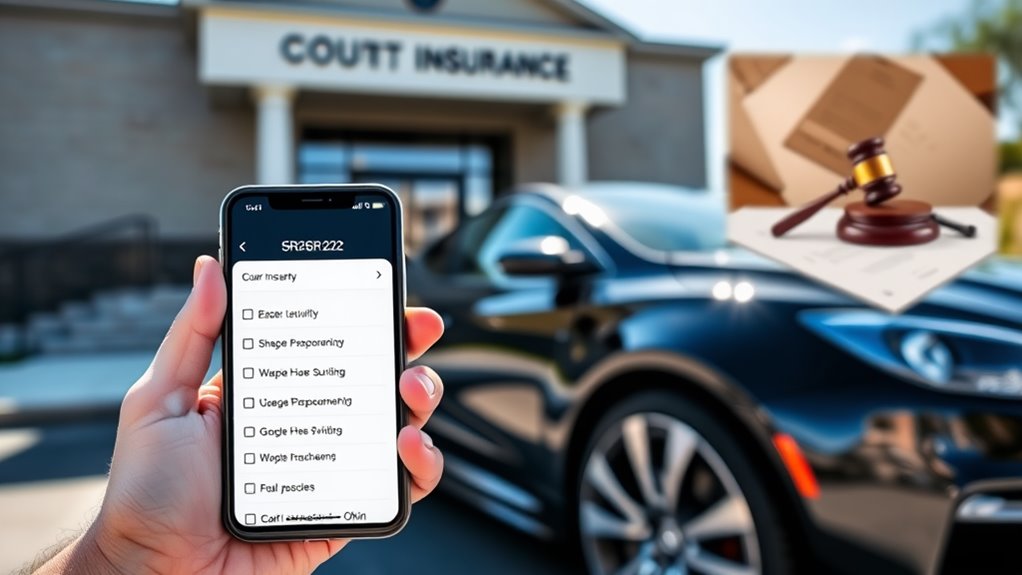Many drivers underestimate the importance of properly renewing their SR-22 insurance, which can lead to severe penalties. It's not just about keeping your coverage active; there are specific steps you need to follow to stay compliant. By understanding the requirements and planning ahead, you can avoid unexpected costs and complications. Let's explore essential tips that can help you navigate the renewal process smoothly.
Key Takeaways
- Track your SR-22 renewal date to ensure continuous coverage and avoid license suspension.
- Review and confirm your insurance details for accuracy before the renewal process.
- Set up automatic payments to prevent lapses in coverage due to missed premium payments.
- Communicate regularly with your insurer to confirm timely SR-22 filings and compliance.
- Compare premiums and coverage options from different insurers to potentially save on costs.
Understand Ohio's SR-22 Requirements

If you're maneuvering through the complexities of Ohio's SR-22 requirements, it's essential to grasp the basics.
An SR-22 form isn't an insurance policy but a certificate confirming you meet Ohio's minimum liability insurance requirements, primarily needed for license reinstatement after suspension. Common triggers for needing an SR-22 include DUI/OVI convictions and driving without insurance. It's important to note that minimum liability coverage includes $25,000 bodily injury, $50,000 total bodily injury, and $25,000 property damage. Understanding your insurance options can help you choose the right policy for your situation.
Typically, you'll maintain this form for three years. The filing process is mostly electronic, taking just a few days. Remember, failure to keep your SR-22 current can lead to another license suspension and increased premiums.
Maintaining your SR-22 for three years is crucial; lapses can result in license suspension and higher insurance costs.
Opting for non-owner SR-22 policies is also possible if you don't own a vehicle. Understanding these elements helps guarantee you remain compliant and maintain your driving privileges.
Confirm Your Coverage Levels
Confirming your coverage levels is essential when maneuvering through SR-22 insurance requirements.
Start by understanding the types of SR-22 policies available: operator, non-owner, and owner/operator. Each type suits different driving circumstances and needs.
Make certain you meet your state's minimum liability coverage, as SR-22 insurance is designed to verify this financial responsibility. You can also consider adding thorough and collision insurance for better protection, but be aware that these options may raise your premiums.
Finally, remember that your SR-22 form must be filed with the DMV to prove continuous coverage. Staying informed about your coverage levels helps you maintain compliance and avoid penalties associated with lapses in insurance.
Set Up Automatic Payments
Setting up automatic payments can markedly streamline your SR-22 insurance management, ensuring your premiums are paid on time. By automating your payments, you can prevent policy lapses that could lead to fines or license suspension.
Timely payments are essential to maintaining your financial responsibility and fulfilling state SR-22 requirements, which typically last 2-3 years. Automatic payments help you avoid the risks associated with missed deadlines, as insurers must notify the DMV if your coverage lapses.
Many insurance providers offer user-friendly platforms that allow you to set up and manage these payments easily. This not only reduces your administrative burden but also provides peace of mind, knowing your coverage remains active without constant oversight.
Keep Track of Renewal Dates

Keeping track of renewal dates is vital for maintaining your SR-22 insurance and guaranteeing compliance with state requirements.
Renewal periods typically range from 1 to 5 years, depending on your state's regulations. Insurance companies usually notify you of upcoming renewal dates via email or mail, so pay attention to those communications.
It's important to maintain continuous coverage, as any lapses can lead to license suspension. Regularly check in with your insurance provider to confirm your renewal status and understand any specific state procedures, which may involve contacting the DMV.
Compare Insurance Premiums
When you're looking for SR-22 insurance, comparing premiums across different companies can save you a significant amount of money. The cost of SR-22 insurance can vary widely, so it's crucial to review your options.
Here are three key points to examine:
- Premium Differences: For example, Progressive offers the cheapest option at $662, while State Farm charges $782, and Travelers is at $917.
- Filing Fees: Some insurers, like Dairyland, might've free SR-22 filing fees, helping you save even more.
- Coverage Levels: Assess whether you need minimum liability or full coverage, as this can greatly impact your premium.
Communicate With Your Insurer
Finding the right SR-22 insurance isn't just about comparing premiums; effective communication with your insurer is key to a smooth process.
Start by contacting your insurer early to minimize delays. Be prepared with necessary information like your driver's license number and reasons for needing the SR-22. Don't hesitate to ask questions about fees, timelines, and state-specific filing requirements.
Keeping track of deadlines is essential; renew your policy in advance to avoid coverage lapses, as most states don't offer a grace period. Maintain continuous coverage, as any lapse can lead to license suspension.
Finally, stay proactive by frequently checking in with your insurer to guarantee all filings are processed correctly and on time.
Explore Discounts and Savings

Exploring discounts and savings on SR-22 insurance can greatly reduce your overall costs, especially when you're maneuvering through the complexities of high-risk coverage.
Here are three key discounts to take into account:
- Multi-Policy Discounts: Bundling your auto insurance with home or renters insurance can save you money.
- Good Driver Discounts: While these mightn't apply immediately, maintaining a clean driving record can help lower your premiums in the future.
- Automatic Payment Discounts: Setting up automatic payments often results in additional savings.
Plan for Potential Premium Increases
As you navigate the complexities of SR22 insurance, it's important to anticipate potential premium increases that could arise from various factors. Your driving record plays an essential role; serious infractions can considerably raise your rates.
Additionally, the type of vehicle you drive matters—newer or high-value cars typically come with higher premiums. Geographic location also influences costs, as state-specific regulations vary widely.
Age and gender are other key factors; younger and older drivers may face increased rates. Finally, a poor credit score can lead to higher premiums.
Be Aware of Lapse Consequences
When you let your SR-22 insurance lapse, you risk facing serious consequences that can complicate your driving privileges and financial situation.
These consequences can include:
- License Suspension: Your driving privileges could be suspended immediately.
- Increased Premiums: Insurers view lapses as a sign of higher risk, leading to increased rates.
- Financial Burden: You may face unexpected fees for reinstatement and higher premiums down the line.
Additionally, lapses get documented on your driving record, making it harder to secure future insurance.
Be proactive in maintaining your coverage to avoid these pitfalls, as the effects can linger and complicate your insurance journey for years to come.
Stay vigilant and informed to guarantee your SR-22 remains active.
Ensure Compliance With State Regulations
Maintaining your SR-22 coverage isn't just about avoiding lapses; it's also about guaranteeing compliance with state regulations.
Every state has specific minimum liability coverage requirements for SR-22, so check your state's rules. Typically, you'll need your SR-22 active for at least three years, but this can vary.
Your insurance provider must file the SR-22 certificate with the DMV once your policy is secured, so notify them promptly to avoid delays.
Understand the two main types of SR-22 policies—owner and non-owner—and choose the one that fits your situation.
Keep copies of all paperwork and confirmation emails to stay organized.
Finally, verify all your address and vehicle information is current to prevent complications with compliance.
Conclusion
Renewing your SR-22 insurance doesn't have to feel like maneuvering through a maze. By staying organized and proactive, you can glide through the process with ease. Keep your eyes on the calendar, communicate with your insurer, and explore your options to find the best coverage at the right price. With a little preparation, you'll guarantee your compliance sails smoothly, avoiding any bumps on the road ahead. Remember, a well-planned path today leads to peace of mind tomorrow.

